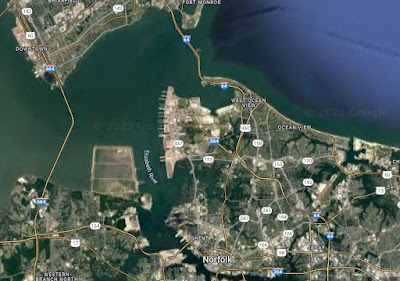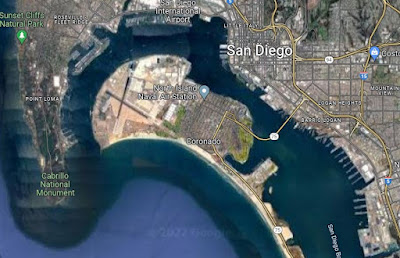The big navalist news over the weekend was unquestionably what appears to be a successful attack on the Russian Navy at Sevastopol by remotely piloted surface craft by the Ukrainians.
Some reports call them "drones" or other such descriptors, but really they appear to be an upscaled militarized remotely piloted surface vessel on a one way trip. There is a lot of expected hyperbole about the attack, and that is what I wanted to address today. I am concerned that the overhype by the ignorant, click hunting, or agenda driven people in the public space will cause us to miss the most important lesson here.
This attack was not historically significant in a larger sense, no more than the attack on the Moskva was. This is not a glimpse into the future of naval warfare. This was simply a continuation of sound naval tactics with a pedigree directly tracible thousands of years in to the past. Not to understand this is to dangerously not understand what happened.
First of all, let's take a moment to state the obvious: the Russians should have been ready. They had about as clear of a warning as possible in September.
A MYSTERIOUS vessel widely believed to be a Ukrainian suicide drone has washed up near to a Russian naval base.
The vessel was found in Omega Bay, by the port of Sevastopol, which is home to Vladimir Putin's Black Sea fleet.
We can safely assume - as the videos below seem to demonstrate - that the ones used in the attack are of the same design.
We will loop back to this point later, but just behold the simplicity of it via the article from The Sun linked above;
This is all COTS technology riding on either a canoe or ocean going kayak. If you have someone with an understanding of explosives and communications (the only part requiring military expertise +/-) and then any garden variety electrician, small engine pro, and fiberglass guy ... you can run a production line of these on a shoestring budget at scale.
They look fragile, but ... well ... I'm getting ahead of myself. Let's finish setting the table.
In a classic, "We live in magical times.." moment, take some time if you have not already to look at the released video we have of the attack as published by The Guardian;
Now that we're through with the fun stuff, let's get to the serious lessons.
First - and this is the most important - this is no transformational breakthrough in warfare at sea. From the start of the written record of naval warfare, attacking another nation's navy - especially a stronger navy - in port with remotely piloted or unmanned surface vehicles has been "a thing."
Before the advent of explosives, they were simple "fire ships" like these Song Dynasty examples;
This is another demonstration that the military culture of Russia is broken. The human element in the Sevastopol was manifested in the complete lack of preparation for the attack in spite of the warnings so clearly provided in September.
As old as "fire ships" are to naval warfare are the defenses to them. They are as simple as the weapons needed to defend against them. Barriers at the water level and crew served weapons - preferable optically sighted - as a backup.
Part of the video above you can see both surface ship and helo gunfire taking out the threat from one boat, but other boats were able to approach surface ships underway and penetrate deep in to port.
Why?
What is one of the things we have repeatedly discussed here for the last 18-years? When war comes you never have enough of what? That's right, anti-aircraft defenses and medium caliber guns including crew served weapons.
We build our ships around the most high-technology threats and equally exquisite defenses against them, but completely overlook the low-tech weapons that are just as deadly. We ignore mine warfare, and we also ignore threats as simple as a converted kayak. It isn't sexy and the contracts awarded are small ... but the threats are real.
There isn't a sexy or expensive defense against them - though you can try to sell one - and the best defense you have are Sailors on watch - with good surveillance equipment to support them - and weapons they can use at scale and volume.
Yes, there is a cost to have increased manning levels, additional weapons in the armory and drills/training to maintain readiness ... but if that is the cost to be ready for war ... then do it.
Look at the early lessons from WWII to the Falkland Islands War etc; at peace we get lazy. When war arrives, we find ourselves lining the rails with anything that can throw lead.
The Russians do not appear to have taken the most obvious and immediate steps to address this cheap, low-tech threat. They did not have significant barriers in place at the entrance to their harbors or around their ships' berths. They did not have Sailors on watch with weapons at the ready.
They were complacent. They were arrogant. They assumed too much.
Now is the time to loop back to a few points made at he top. This is where everyone needs to focus their attention.
1. For thousands of years, weaker naval forces have significantly damaged superior naval forces by using their disadvantage to advantage. When large and heavily armed warships are designed, trained, and manned for war against their peers on the high seas, how do you best attack them? Inshore with simple; small, lightly armed civilian derived boats roughly designed, simply trained, and unmanned.
Be it a raft filled with burning straw and tar, or a butched-up sea-kayak filled with RC boat tech, commercial satellite data, Sea-Doo propulsion, duct taped explosives and contact detonators. If the larger naval force in a mix of arrogance and bureaucratic sloth, or just professional malpractice, refuses to see the full-spectrum vulnerability - even when I&W tells you it is there - then the motivated, flexible, and capable smaller power will reach in to history's toolbag to pick out the best bang for the buck.
2. You do not have to be a state power to create the modern "fire ship." You do not have to access controlled technology. You don't need even a lot of money. You just need imagination and the bare minimum of technical capability.
3. Most readers here are familiar with San Diego, Norfolk, Mayport and our other major naval bases. Can you wargame the rest? Yes, we have some nice barriers you can even see from GoogleEarth, but what about getting from the pier to the open sea in 2022? Where could the enemy hide? How much warning do you have? How many crew served weapons do you have ready ... and what is your ROE in such crowded ports? I don't know about you, but I like Mayport even more now.
Good on the Ukrainians for using this time proven tactic. It was clear the Russians were not ready for it - a common characteristic of the Russian military - so the Ukrainians took advantage of the Russians' sloth.
As for the US military, I'm really not interested in the question of how we could use such tactics, but as we are the big Navy, I want to know more what we do to protect ourselves from this tactic.
We can start with what is the most obvious: more crew served weapons.
More smaller boats to escort our ships to sea (USCG or USN, don't care).
If I were a state or non-state actor watching this scene - I'd already have plans in place and just wait for the moment to be ripe.
I hope we are ready for same.







_while_providing_port_security.jpg)























